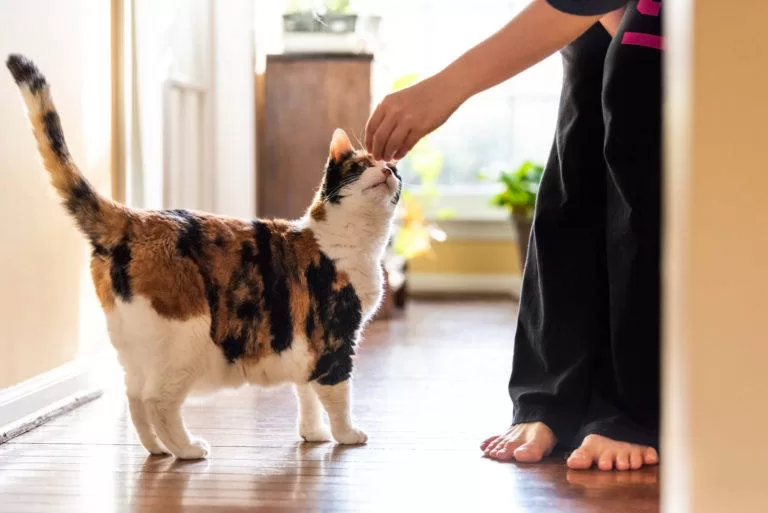If you have a cat, it is important that it is properly trained to ensure its safety and well-being. Basic cat training can help set limits and teach desirable behaviors. In this article, we’ll explore the simple steps to start training your cat.

The importance of compatibility between cats and children
The relationship between cats and children can be incredibly rewarding, but it also requires care and attention to ensure the safety and well-being of both parties. It is essential to establish adequate compatibility between cats and children from the beginning so that they can develop a healthy and lasting bond.
First, it is important to understand that not all cats are suitable for living with children. Some cats may be more shy, aggressive or simply not used to children’s energy and unpredictability. So before bringing a cat home, be sure to choose a breed known for its compatibility with children or consult a cat behaviorist for guidance.
Furthermore, it is essential to prepare the house for the cat’s arrival. Make sure there are safe areas for the cat to take refuge and hide, such as high shelves or a climbing tree. Remove fragile or dangerous objects that could be accidentally dropped by children. It is also important to teach children to respect the cat’s limits, explaining that they need moments of peace and tranquility.
When introducing the cat to your child, do so gradually and under supervision. Allow the cat to explore the environment while the child watches from afar. Gradually allow the child to approach and offer treats or toys to create a positive association. Remember that patience is essential in this process, as the cat may need time to get used to the child’s presence.
Also, teach children how to interact with the cat safely. Explain the importance of gently petting, avoiding tail or ear pulling, and never waking the cat while it is sleeping. It is essential that children understand that cats have limits and that they need to be respected to ensure the safety of both parties.
Establishing a care and play routine is essential to strengthen the bond between the cat and the child. Encourage children to participate in feeding, brushing and cleaning the cat’s litter box. Additionally, promote fun activities that involve the cat and the child, such as playing sessions with fishing wands or toy balls. These activities together will help build a relationship of trust and fun.
Finally, it is important to properly deal with behavior problems that may arise between cats and children. Teach children to recognize your cat’s signs of stress or discomfort and to move away when necessary. Furthermore, reinforce the importance of not teasing or scaring the cat, as this can lead to aggressive reactions.
Compatibility between cats and children requires patience, education and constant supervision. By following these tips and establishing a solid foundation from the beginning, it is possible to promote a harmonious and safe relationship between cats and children, which will bring joy and benefits to both parties.

Preparing the house for the cat’s arrival
When bringing a cat home, it is essential to prepare the environment to ensure the cat feels safe and comfortable. Here are some important steps to take to prepare your home for your new feline’s arrival:
1. Dedicated space
Before bringing your cat home, choose a dedicated space for your cat to familiarize themselves with at first. This could be an empty room or a quiet corner of the house. Make sure the space is safe and free from any objects that are dangerous to the cat.
2. Hiding places and scratching posts
Cats love having places to hide and scratch. Be sure to provide different options, such as cardboard boxes, dens, or scratching trees. This will help the cat feel safe and prevent it from damaging furniture or carpets.
3. Food and water
Prepare a specific place for the cat’s food and water. Make sure it is away from the litter box and in a quiet area of the house. Set out clean, fresh water and food bowls daily.
4. Litter box
Provide a suitable litter box for your cat. Make sure it’s big enough for him to move around comfortably and that it’s always clean. Place the litter box in a quiet area of the house, away from its food and water.
5. Toys and environmental enrichment
Ensure the cat has a variety of toys and opportunities for environmental enrichment. This includes interactive toys, vertical scratching posts, horizontal scratching posts, and climbing shelves. These items will help keep your cat entertained and stimulated.
By following these tips and properly preparing your home for your cat’s arrival, you will be providing a welcoming and safe environment for your cat to adapt. Remember to be patient and give the cat time to explore and adjust to its new environment. Over time, he will feel comfortable and become part of the family.

Introducing the cat to the child
When it comes to introducing your child to a new cat, it’s important to follow a few steps to ensure a smooth and safe transition. Here are some tips to help with this process:
- Constant supervision: During the first interactions between the cat and the child, it is essential to be present and supervise closely. This will allow you to intervene if there is any inappropriate behavior or aggression on the cat’s part.
- Gradual introduction: Start by allowing the cat and child to become familiar with each other’s scent. Give the child a piece of the cat’s clothing to hold and vice versa. This will help reduce anxiety and allow you both to get used to each other’s scent.
- Protect the cat: Make sure the cat has a safe space to hide and retreat if he feels the need. This could be an elevated area, such as a shelf or an open carrier, where the cat can take refuge when needed.
- Encourage positive interactions: Encourage the child to interact with the cat in a gentle and calm way. Teach her to pet the cat gently and avoid sudden gestures or grabbing that could scare the animal.
- Reward good behavior: Praise and reward both the cat and the child when they behave appropriately during interactions. This will strengthen the positive association between them and reinforce desirable behaviors.
- Respect limits: If the cat shows signs of discomfort or stress, respect its space and give it time to get used to the child’s presence. Forcing the interaction can result in aggressive behavior on the part of the cat.
Remember that each cat has its own personality and it will take time to adapt to the presence of a child in your life. Be patient and continue working on building a positive relationship between the cat and the child.
Teach children how to interact with cats safely
When we bring a cat home and there are children involved, it is important to teach the little ones how to interact with the new family member in a safe way. Here are some tips to help ensure a positive interaction between children and your cat:
1. Teach respect for limits
Explain to children that cats are independent animals and may need space and time alone. Teach them to respect the cat’s limits and not to force interaction when the cat is not interested. This will help avoid stressful situations for the cat and possible scratches or bites.
2. Demonstrate how to properly pet
Show children how to pet the cat gently and gently. Teach them to stroke in the direction of the fur and avoid touching sensitive areas, such as the belly or ears. Explain that if the cat is not enjoying the affection, it is important to stop and respect the cat’s wishes.
3. Avoid aggressive play
Teach children to avoid aggressive play with the cat, such as pulling the tail, squeezing the body, or chasing the cat. These games can scare the cat and cause it to react defensively. Encourage gentle play, such as using feathered wands or toy balls.
4. Supervise interactions
It is important that an adult is always present to supervise interactions between the child and the cat. This will ensure the safety of both parties and allow interventions to be made if any unwanted situation occurs.
5. Teach your cat signs of stress
Explain to children how to identify signs of stress in your cat, such as ears back, a bristled tail or growling. This will help children recognize when the cat is uncomfortable and respect the animal’s need for space.
Always remember that each cat is unique and may have different levels of tolerance to interactions with children. Therefore, it is essential that children are taught to treat the cat with respect and to adapt to the animal’s individual needs. With patience and proper guidance, children can develop a safe, loving relationship with their pet cat.

Establishing a care and play routine
Once the child and cat are adapting to each other, it is important to establish a care and play routine to ensure a harmonious coexistence. Here are some tips to help create that routine:
- Feeding: Set fixed times to feed the cat and involve the child in the process. Show her how to measure the correct amount of food and let her put the food in the cat’s dish. This helps strengthen the bond between them and teaches the child about responsibility.
- Hygiene: Teach your child the importance of keeping the sandbox clean. Show how to remove waste and change the sand regularly. Encourage her to participate in this process, so she feels responsible for the cat’s well-being.
- Games: Encourage interaction between the child and the cat through games. Teach your child to use toys suitable for cats, such as wands with feathers or fur balls. Supervise play to ensure it is safe and that the child does not harm the cat.
- Rest: Make sure your cat has a quiet space to rest. Explain to the child that the cat may need moments of calm and privacy. Teach her to respect these moments and not to disturb the cat when she is resting.
- Sleep: Establish a sleep routine for your cat, respecting its rest needs. Explain to the child that the cat can sleep during the day and that it is important not to wake it up. This prevents the cat from becoming irritable and helps prevent potential behavior problems.
- Affection: Encourage the child to show affection for the cat, but teach them how to do so appropriately. Show her how to pet the cat gently, avoiding hair pulling or sudden movements. Reinforce the importance of respecting the cat’s limits, respecting him when he prefers not to be petted.
Remember that the routine can vary depending on the needs of the cat and child, and it is important to adapt it as necessary. Also, never leave a child alone with a cat, especially if the child is very young. Constant supervision is essential to ensure the safety of both.
Establishing a care and play routine is essential to promote harmony between cats and children. With patience, dedication and mutual respect, it is possible to create an environment in which coexistence is pleasurable and enriching for everyone.
Dealing with Behavior Problems Between Cats and Children

When it comes to coexistence between cats and children, it is common for some behavioral problems to arise. However, it is important to deal with these issues appropriately to ensure the safety and well-being of both of you.
One of the most common problems is when the cat scratches or bites the child during play. This may occur due to the cat’s lack of understanding of the limits of play or when it feels threatened. In this case, it is important to teach the child to interact appropriately with the cat, avoiding sudden movements and respecting the animal’s space. Furthermore, it is essential to provide your cat with appropriate toys so that it can release its energy and natural instincts.
Another common problem is when the cat feels invaded in its personal space, such as its resting or eating area. This can lead to the cat becoming aggressive or avoiding these places. To avoid this situation, it is important to teach the child to respect the cat’s spaces and not to disturb him while he is in those places. Furthermore, it is important to ensure that the cat has its own safe places to rest and eat.
If the cat displays recurrent aggressive or fearful behavior towards the child, it is recommended to seek help from a professional, such as a veterinarian or an animal behaviorist. They will be able to assess the situation and provide specific guidance to resolve the issue.
It is important to remember that training cats and living with children requires patience and dedication. Each animal is unique and can take time to adapt to new situations. Therefore, be patient and be willing to invest time and effort to ensure a harmonious relationship between the cat and the child.
By following the tips and guidelines mentioned in this article, you will be on the right path to establishing a healthy and happy relationship between cats and children. Remember that, in addition to training, it is important to promote a safe and enriching environment for both, providing the love, care and attention necessary for the well-being of both.

Final Thoughts and Additional Tips to Ensure Compatibility
After following the previous steps to ensure compatibility between cats and children, it is important to be aware of some final considerations and additional tips to maintain a harmonious and safe environment for everyone.
1. Always supervise interactions
Even if the cat and child are getting along great, it is essential to supervise their interactions. Children can be excited and even abrupt in their play, and this can scare or hurt the cat. Therefore, always stay close by to intervene if necessary.
2. Teach limits and mutual respect
It is important to teach children that cats are living beings with their own needs and limits. Explain that they need rest, moments of tranquility and respect. Demonstrate how to pet the cat gently and appropriately, avoiding grabbing it roughly or pulling its tail.
3. Encourage shared responsibility
Involving children in cat care tasks is a great way to encourage responsibility and a sense of care. Teach children how to feed the cat, change the water, clean the litter box and brush its fur. Over time, they will understand the importance of these tasks and develop an even greater bond with the animal.
4. Provide an enriched environment
Cats are curious animals and need physical and mental stimulation. Be sure to provide toys, scratching posts, and comfortable resting places for your cat. This will help prevent him from becoming bored and frustrated, reducing the chances of behavior problems.
5. Be aware of signs of stress or discomfort
Observe your cat and children’s behavior regularly. If you notice signs of stress, such as aggression, constant hiding or changes in appetite, it is important to seek help from a veterinarian or an animal behaviorist. They will be able to assess the situation and offer specific guidance for your case.
By following these final considerations and additional tips, you will ensure the safety and well-being of both cat and child. Remember that patience and mutual respect are essential to building a healthy and lasting relationship between them. Over time, they will learn to live together harmoniously, providing joy and companionship for the whole family.
External Links:

